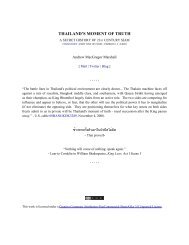THAILAND'S MOMENT OF TRUTH - ZENJOURNALIST
THAILAND'S MOMENT OF TRUTH - ZENJOURNALIST
THAILAND'S MOMENT OF TRUTH - ZENJOURNALIST
You also want an ePaper? Increase the reach of your titles
YUMPU automatically turns print PDFs into web optimized ePapers that Google loves.
act of limited or temporary noncooperation. If the number of persons willing to act<br />
is small, then the initial act might, for example, involve placing flowers at a place of<br />
symbolic importance. On the other hand, if the number of persons willing to act is<br />
very large, then a five minute halt to all activities or several minutes of silence might<br />
be used. In other situations, a few individuals might undertake a hunger strike, a vigil<br />
at a place of symbolic importance, a brief student boycott of classes, or a temporary<br />
sit-in at an important office. Under a dictatorship these more aggressive actions<br />
would most likely be met with harsh repression.<br />
Certain symbolic acts, such as a physical occupation in front of the dictator’s palace<br />
or political police headquarters may involve high risk and are therefore not advisable<br />
for initiating a campaign. [Sharp, From Dictatorship to Democracy]<br />
On June 26, 2010, Sombat tied red ribbons around a street sign at the northeast corner of<br />
the Ratchaprasong intersection. It was a simple, individual gesture of resistance against the<br />
government’s efforts to erase the memory of the May killings. He was immediately arrested,<br />
and held in detention for two weeks.<br />
Just two days after his release, on July 11, Sombat was back at Ratchaprasong, this time with<br />
dozens of supporters. Around 30 protesters suddenly swept through the crowds of Sunday<br />
afternoon shoppers and converged on the street sign. Some began fixing red tape and ribbons<br />
around the sign; others held up placards printed in Thai and English with the words: “People<br />
died here.” They chanted the same words, in Thai, a simple remembrance of the dead.<br />
Three protesters daubed in red paint lay motionless on the sidewalk in a symbolic piece of<br />
street theatre. And as a small crowd of curious onlookers and journalists gathered, Sombat<br />
appeared, wearing a white T-shirt printed with the slogan “I am red”, and wrapped a red cloth<br />
banner around the base of the sign. It was a tiny protest, particularly by the standards of the<br />
vast Red Shirt rallies earlier in the year, and that was its strength. Several police were present<br />
to observe, but kept their distance, even though political gatherings of more than five people<br />
were banned under the state of emergency. The authorities had learned by now that arresting<br />
people merely for tying red ribbons to a street sign and saying that people had died in the area<br />
made them look heavy-handed and oppressive. The protesters dispersed unmolested, having<br />
widened the space for peaceful political dissent a little further.<br />
Week after week, Sombat’s “Red Sunday” group staged events so self-consciously nonconfrontational<br />
that the authorities they very successfully satirized remained unsure how<br />
seriously to take them or how to respond. On July 25 there was a Red aerobics event in<br />
Lumphini Park; some of those who took part in the exercise session were daubed with fake<br />
blood or painted their faces into the grotesque death masks of ghosts or zombies. On August<br />
1, scores of Red Shirts lay on the ground at the Democracy Monument in memory of the<br />
dead. Another event in Lumpini park on August 8 drew more than 500 people; a week later<br />
it was 600. On September 12, Sombat organized a Red bicycle rally in the area around<br />
Ratchaprasong, pausing at places where people had died during the May violence. Cyclists<br />
yelled “soldiers shot the people” and “we do not forget” as they pedalled along the streets.<br />
Meanwhile, a small group of students from the Prakai Fire Group with ghoulish make-up and<br />
torn, bloodied clothes held a procession on foot and by Skytrain from Wat Pathum Wanaram.<br />
Many dismissed these events as irrelevant, and Sombat was often portrayed in the media as a<br />
lunatic or a clown. But they were part of a deliberate strategy to expand the possibilities for<br />
protest and help potential supporters overcome their fear, ahead of a large commemorative<br />
rally planned for September 19. As Sombat told Peter Boyle of the Green Left Weekly:<br />
10<br />
We organised a process to break down this fear. The build-up events were symbolic<br />
appearances that were not big enough to provoke the full force of government.




